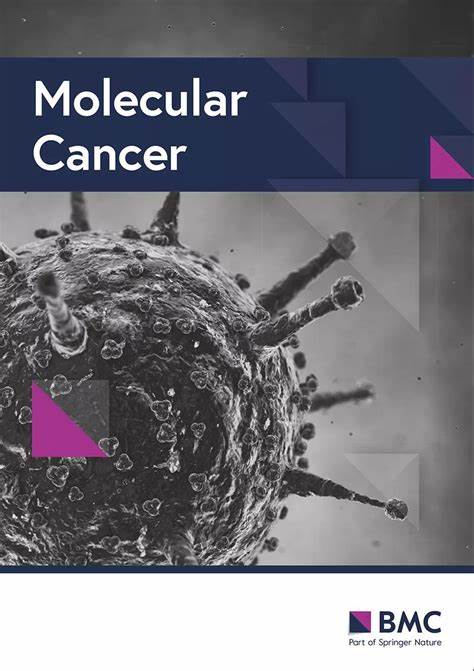局部晚期食管鳞状细胞癌围手术期纳武单抗和化疗:循环肿瘤DNA动力学监测的随机多中心2期研究
IF 27.7
1区 医学
Q1 BIOCHEMISTRY & MOLECULAR BIOLOGY
引用次数: 0
摘要
虽然新辅助化疗和免疫治疗在治疗食管鳞状细胞癌(OSCC)方面显示出希望,但长期生存数据有限。这项随机、多中心的2期研究评估了局部晚期可切除的OSCC患者围手术期Nivolumab联合化疗、手术和辅助免疫治疗的疗效,并探讨了循环肿瘤DNA (ctDNA)状态对预后的影响。在这项试验中,从五个中心招募的参与者以2:1的比例随机分配,在化疗(顺铂和紫杉醇)的基础上接受围手术期Nivolumab或安慰剂,随后进行微创食管切除术。对于那些没有达到病理完全缓解(pCR)的患者,给予尼武单抗辅助治疗。成功的主要衡量标准是pCR率,次要终点包括R0切除率、无事件生存期和总生存期。所有结果和安全措施都是根据意向治疗人群进行评估的。监测ctDNA水平作为探索性终点。90名患者入组,随机接受尼武单抗或安慰剂加化疗。与对照组(13.3%)相比,尼武单抗组(15%)的pCR率略高(相对风险,1.13;95% CI, 0.38 - 3.36)。R0切除率无显著差异(96.4% vs 96.6%;p > 0.05)。中位随访时间为24.9个月(四分位数范围:22.8至26.7个月)。尼武单抗组的两年无事件生存率为63.11%,化疗组为60.47%(风险比,0.97;95% CI, 0.49 ~ 1.92)。2年总生存率分别为83.32%和79.4%(风险比0.82;95% CI, 0.29 - 2.31)。所有参与者在基线时都是ctDNA阳性,但治疗后,89%的Nivolumab组和62.5%的安慰剂组转为ctDNA阴性(P = 0.01)。在所有检测点ctDNA阴性的患者无病生存率显著提高(P < 0.001)。围手术期纳武单抗加化疗是系统性治疗局部晚期可切除OSCC的可行且安全的选择。通过ctDNA监测微小残留疾病可能对评估辅助治疗的有效性和系统性预后评估具有潜在价值。ClinicalTrials.gov注册编号:NCT05213312。本文章由计算机程序翻译,如有差异,请以英文原文为准。
Perioperative nivolumab and chemotherapy in locally advanced squamous cell carcinoma of the oesophagus: a randomized multicentre phase 2 study with circulating tumor DNA dynamics monitoring
Although neoadjuvant chemotherapy and immunotherapy show promise in treating oesophageal squamous cell carcinoma (OSCC), long-term survival data are limited. This randomized, multicenter phase 2 study evaluated the efficacy of perioperative Nivolumab with chemotherapy, followed by surgery and adjuvant immunotherapy, in patients with locally advanced resectable OSCC, and explored the prognostic role of circulating tumor DNA (ctDNA) status. In this trial, participants recruited from five centers were randomly assigned in a 2:1 ratio to receive either perioperative Nivolumab or a placebo in addition to chemotherapy (cisplatin and paclitaxel), followed by minimally invasive esophagectomy. For those who did not achieve a pathological complete response (pCR), adjuvant treatment with Nivolumab was administered. The main measure of success was the pCR rate, with secondary endpoints including the R0 resection rate, event-free survival, and overall survival. All outcomes and safety measures were assessed based on the intention-to-treat population. ctDNA levels were monitored as exploratory endpoints. Ninety patients were enrolled and randomized to Nivolumab or placebo plus chemotherapy. The pCR rate was slightly higher in the Nivolumab group (15%) compared to the control group (13.3%) (relative risk, 1.13; 95% CI, 0.38 to 3.36). No significant differences were observed in R0 resection rates (96.4% vs. 96.6%; P > 0.05). The median follow-up duration was 24.9 months (interquartile range: 22.8 to 26.7 months). Two-year event-free survival rates were 63.11% in the Nivolumab group versus 60.47% in the chemo group (hazard ratio, 0.97; 95% CI, 0.49 to 1.92). Two-year overall survival rates were 83.32% and 79.4%, respectively (hazard ratio, 0.82; 95% CI, 0.29 to 2.31). All participants were ctDNA positive at baseline, but post-treatment, 89% of the Nivolumab group and 62.5% of the placebo group turned ctDNA negative (P = 0.01). Those negative for ctDNA at all testing points showed significantly better disease-free survival (P < 0.001). Perioperative Nivolumab plus chemotherapy is a viable and safe option for systemically treating locally advanced resectable OSCC. Monitoring minimal residual disease through ctDNA could be potentially valuable for assessing the effectiveness of adjuvant therapy and for prognostic evaluation in a systemic manner. ClinicalTrials.gov registration NCT05213312.
求助全文
通过发布文献求助,成功后即可免费获取论文全文。
去求助
来源期刊

Molecular Cancer
医学-生化与分子生物学
CiteScore
54.90
自引率
2.70%
发文量
224
审稿时长
2 months
期刊介绍:
Molecular Cancer is a platform that encourages the exchange of ideas and discoveries in the field of cancer research, particularly focusing on the molecular aspects. Our goal is to facilitate discussions and provide insights into various areas of cancer and related biomedical science. We welcome articles from basic, translational, and clinical research that contribute to the advancement of understanding, prevention, diagnosis, and treatment of cancer.
The scope of topics covered in Molecular Cancer is diverse and inclusive. These include, but are not limited to, cell and tumor biology, angiogenesis, utilizing animal models, understanding metastasis, exploring cancer antigens and the immune response, investigating cellular signaling and molecular biology, examining epidemiology, genetic and molecular profiling of cancer, identifying molecular targets, studying cancer stem cells, exploring DNA damage and repair mechanisms, analyzing cell cycle regulation, investigating apoptosis, exploring molecular virology, and evaluating vaccine and antibody-based cancer therapies.
Molecular Cancer serves as an important platform for sharing exciting discoveries in cancer-related research. It offers an unparalleled opportunity to communicate information to both specialists and the general public. The online presence of Molecular Cancer enables immediate publication of accepted articles and facilitates the presentation of large datasets and supplementary information. This ensures that new research is efficiently and rapidly disseminated to the scientific community.
 求助内容:
求助内容: 应助结果提醒方式:
应助结果提醒方式:


